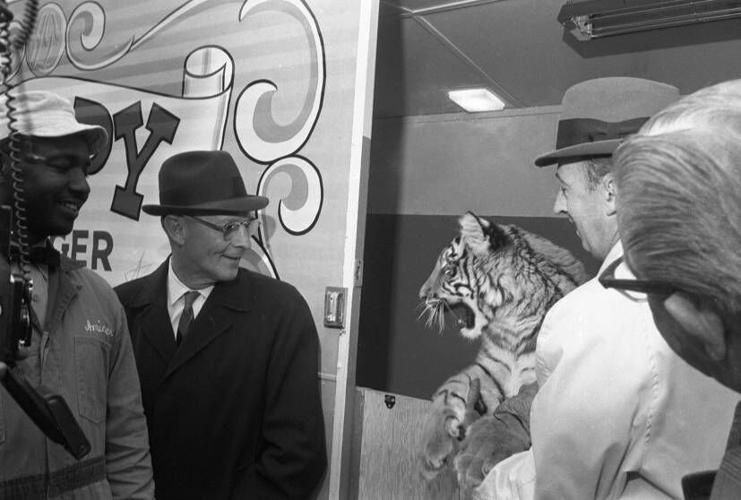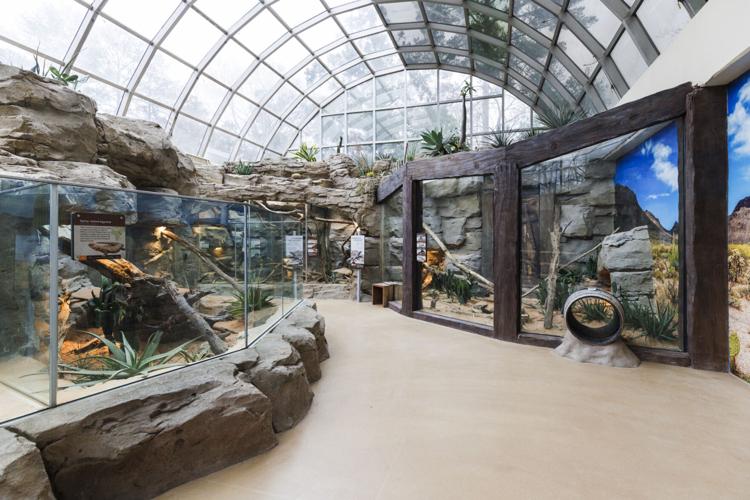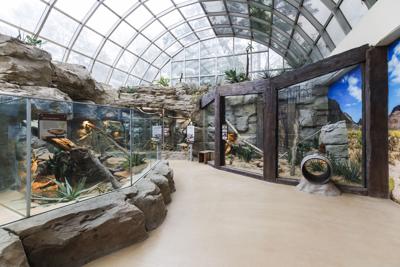COLUMBIA — Sometimes, a little persistence and one tiger are all it takes.
Even though an attempt to build a park for kids failed in the 1960s, it would spark the momentum to create the Riverbanks Zoo in Columbia.
Like any zoo worth its name, there must be a big cat. But one of the first animals to call Riverbanks home wasn't in the zoo as it is today.
It could be found right off Gervais Street at Constan Car Wash.

People gather around Happy, a tiger that was bought and kept by the owner of Constan Car Wash in Columbia. The owner hoped the exotic attraction would spur zoo efforts.
The iconic Columbia business, which closed in 2022, was home to Happy, a tiger that owner O. Stanley Smith purchased from a zoo in Chicago, according to Matt Perron, public relations manager at Riverbanks Zoo. Smith hoped the tiger would be a catalyst to open a zoo in Columbia.
While the initial concept, known as the Columbia Zoo, didn’t manifest, the dream continued.
How Riverbanks Zoo came about
In 1969, the South Carolina General Assembly created a legal authority, the Rich-Lex Riverbanks Park Special Purpose District, to pave the path for Riverbanks Zoo & Garden, which opened on April 25, 1974. Lexington and Richland counties and the City of Columbia partnered on the project, which had 100 acres of designated land along each side of the Lower Saluda River.
Over the next few decades, the Zoo became a powerhouse as one of South Carolina's top attractions, a significant economic driver in the Midlands and a leader in conservation.

The opening press conference at Riverbanks Zoo in Columbia, SC in April 1974.
And 50 years after its gates first opened, Riverbanks Zoo & Garden continues to draw visitors from across the Southeast.
Riverbanks was already seen as something special less than a decade into its existence. It was recognized as "South Carolina's Most Outstanding Attraction" by the S.C. Chamber of Commerce in 1985.
The Zoo expanded its exhibits in the 1980s, opening the Education Center in 1983 and the Aquarium-Reptile Complex in 1989. A significant addition took place in 1995 with the opening of the Riverbanks Botanical Garden.
The early and mid-2000s were marked by expansion, including several new habitats and broken attendance records. In 2018, the Zoo was voted fifth best in the country by USA Today’s 10 Best Readers' Choice poll.

The Darnall W. and Susan F. Boyd Aquarium & Reptile Conservation Center offers an immersive experience for guests of the Riverbanks Zoo and Garden.
'Your visit saves wildlife'
Along with its history as a major attraction, Riverbanks Zoo & Garden has established itself as a leader in conservation. Perron said this is weaved into every part of the zoo’s work, from its mission statement to signage at the entrance, which says, "Your visit saves wildlife."
Through the Satch Krantz Conservation Fund, Riverbanks distributes grant money worldwide to assist conservation projects.
There's also a focus on sustainability and eco-friendly with the products used at the Zoo.
"We've switched out our drinking straws, so there's no plastic drinking straws," Perron said. "Everything's made from recycled oyster shells that breaks down in a couple of weeks."
Perron noted that Riverbanks is one of 250 zoos accredited by the Association of Zoos and Aquariums as part of its Saving Animals From Extinction (SAFE) program, which connects partner zoos in a breeding program to ensure endangered species can reproduce with genetic stability.

Happy, a tiger once kept at Constan Car Wash in Columbia, prowls his enclosure at the Riverbanks Zoo in 1974.
Perron said Riverbanks sets the standard for conservation in Southeastern zoos. Southern White Rhinos from the zoo have been trained to voluntarily give enough blood to be spun into plasma, which any zoo in the country can use to support their rhino population.
Riverbanks has also helped people out when they need it, sending antivenom to North Carolina for someone who was bitten by a green mamba snake.
Perron credits former Executive Director Satch Krantz with having the vision to develop Riverbanks into what it is today. Krantz led the Zoo from 1976, when he was 26 years old, until his retirement in 2017.
"He really got into the conservation and business sense of it, too," Perron said. "[He] was able to pull Lexington and Richland County together."
$80 million expansion aims to boost tourism
Perron said Riverbanks was in its own league when compared to other zoos in the Southeast. By 1990, attendance had passed 1 million annually. It now averages 1.3 million visitors every year.
Perron said this level of interest has made Riverbanks a major economic engine in the Columbia area. According to its own economic development study, Riverbanks Zoo contributes $148 million to the local economy every year, much of which is attributed to out-of-town visitors.
"51 percent of those (visitors) come from outside 50 miles," he said. "They're staying in our hotels, eating in our restaurants."
As Riverbanks eyes the future — $80 million in bond-backed expansions are in the works — Perron said they expect the visitors and local impact only to increase.

Construction at Riverbanks Zoo before its opening in April 1974.
"Overall, and with our expansion that's coming in the next ten years, 'The Brave Through the Wild,' we're estimating our attendance to go up to 1.6 million, which will up the economic impact to $180 million annually."
The new project will feature a multipurpose facility on the Saluda River, including a restaurant, a primate forest with a bridge and a new tram system.
New animal exhibits are also planned, including a Komodo dragon breeding facility that will open in spring 2024.
When it comes to legacy, Perron believes the zoo has the potential to be a place where visitors spend an entire weekend exploring.
"I'm hoping at the 100-year anniversary that there will be kids who were here today," he said. "Eight years old today come to the 50th and come to the 100 year and be like, 'I can't believe how different it is now than it was then.'"















